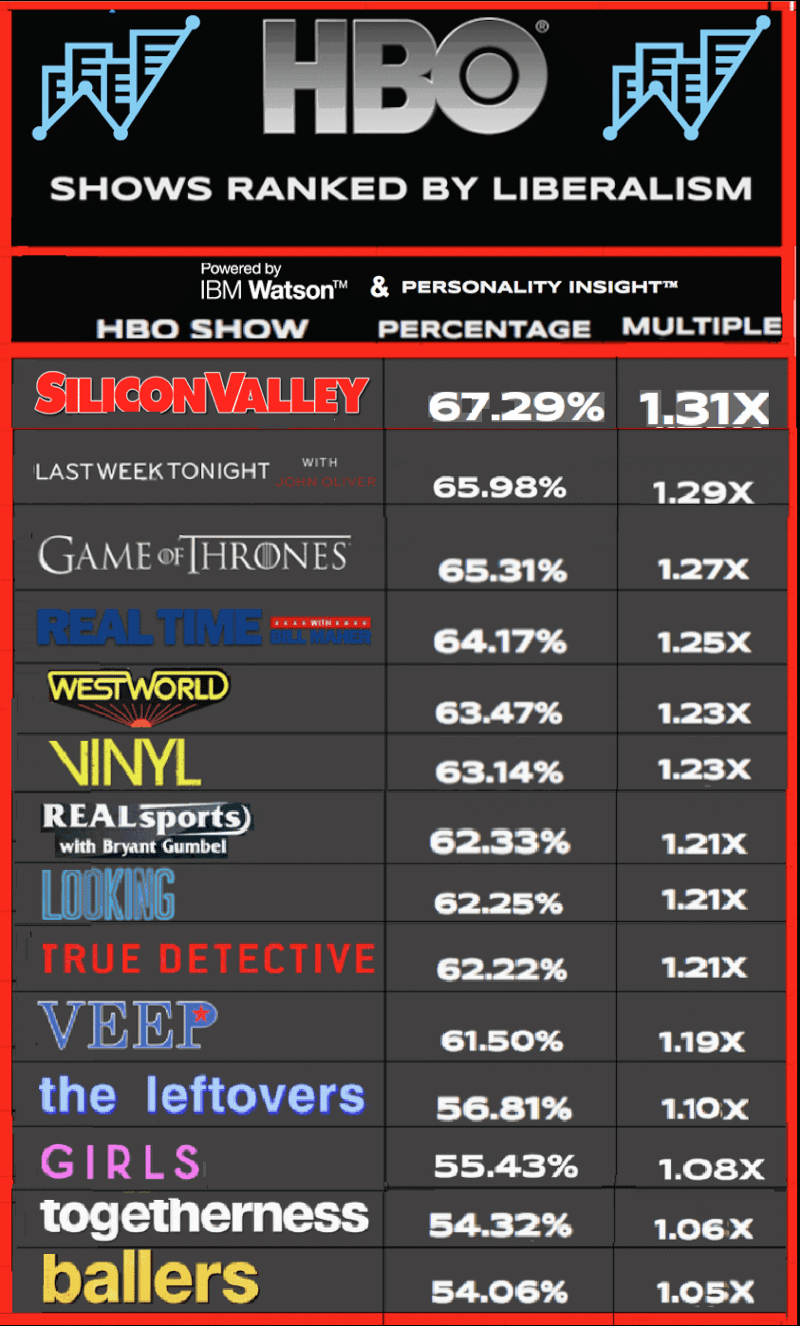
Ignoring the vocal many who believe all of mass media is liberal in its bias — via conspiracy or coincidence — would you personally consider HBO a particularly liberal network?
Well, we see with our own two eyes that even Ballers has an audience that is over 50% liberal. One might be inclined to answer the question “yes,” and move on.
But hold up…
Why are we asking? And who are we? If you are lucky enough to find yourself at StatSocial for the first time, we’ll explain. What we do here is analyze social media audiences. By which we mean any group of individuals who have gravitated toward one another in a social media context, or who you or I have bunched together ourselves. All self-identified redheads from Des Moines who listen to the Shirelles?
We can, if there are any of them, tell you what laundry detergents they prefer, what TV shows they watch, how old they are, in what geographic regions besides Des Moines they’re most common, and honestly just about anything you could imagine.
Fans, vocal detractors, hashtaggers, and for marketers — whose attention we’d love most of all to get — of greatest value, your own audience. No longer need your social media marketing campaigns consist of so much guess work and crossed fingers. You’ll know from day one with whom you’re communicating.
We get inside the audience, and we stress virtually any social audience you could imagine, and tell you who they really are as people.
Lately, for fun and education and as fans of the network, we’ve been focusing our blog entries on the programs of HBO. In this instance — with the assistance of our exciting partnership with IBM Watson and the integration of their Personality Insights™ tool into our reports — we are seeing which of HBO’s current shows’ audiences are most liberal.

The victor by a safe margin is Silicon Valley;. At times satirical (created by the great Mike Judge of Beavis and Butthead, Office Space, and Idiocracy fame), but during too many moments for comfort — since it deals with an industry already so grotesque and bizarre (and from all ends, from the multi-billion dollar multi-national to the wannabe entrepreneur in his garage) — it can just tell the truth and allow the industry it portrays with bone chilling accuracy to ridicule itself.
But it’s also as exquisitely plotted a sitcom as there’s ever been, and not one single member of its ensemble cast falls short of being Emmy worthy. Oh, and against all odds, even though they’re not always the most scrupulous, or brave, or reasonable bunch, you consistently root for the central characters.
The very unique region of northern California that shares the program’s name is so prominent it’s almost one of the characters. But, as tech folks who’ve never set foot in Palo Alto, we — and every single other person we’ve ever met in tech, pretty much all of whom watch Silicon Valley — will assure you it has nailed the entire industry; from the billionaire to the bottom feeder.
While the voting record of the real-life Silicon Valley is overwhelmingly Democrat, as tends to be the case among all tech types for reasons we couldn’t even begin to guess at, IBM Watson and their excellent Personality Insights™ tool does not define “liberal” and “conservative” in quite so cut and dried left/right terms
Personality Insights™ defines liberalism as “a readiness to challenge authority, convention, and traditional values.” Which if extrapolated upon starts to sound like something closer to “classical liberalism,” which by most modern definitions is considered a conservative ideology.
It can all get kind of confusing.
But we’re not here to teach political science, we’re here to beguile you with StatSocial science.
As background for our conclusions…
The baseline for all of our calculations — unless otherwise noted or specially requested — is the average social media audience. To what degree do the audiences of these shows conform to, or defy, Personality Insights’ definition of liberalism when compared to the average?
Below is a quick and dirty example of the sort of basic data you’d find in a StatSocial report (these, incidentally, are the top TV shows with Silicon Valley’s fans; starting with number two, as number one is rather evident.)
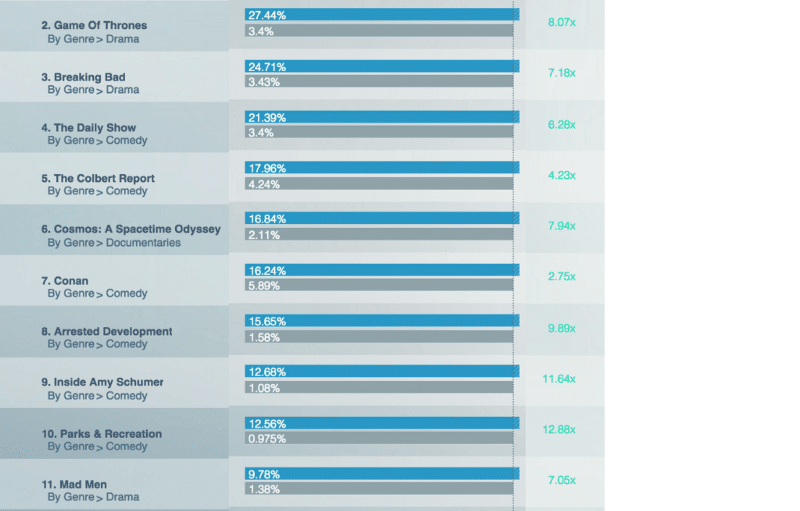
click to enlarge
The blue line is the actual percentage of fans of the audience being analyzed who are also fans of the corresponding item on the list. The grey line represents the baseline; which, as we say, will usually be the average of all of social media as a whole. Finally is one of our favorite and most special metrics, “the multiple,” which tells you the likelihood of one specific audience’s member also being a member of another specific audience.
For example, based on the chart above, we know that fans of Silicon Valley are 12.88 times more likely to be fans of Parks and Recreation than the average social media user. You can read a whole lot about the “multiple” and how game changing it can be, by by visiting blog.statsocial.com and clicking around
But we digress…
While this isn’t about governmental policy and politics, per se, the natural next place to look are all the same the network’s most overtly political shows. HBO currently runs two programs of direct political commentary, satirical in nature though they both may be. First, there’s the panel show, Real Time with Bill Maher.
Hosted, as it is, by an individual of unmistakably left-leaning, progressive views, he indeed famously does not toe the party line to the letter. He has cultivated an image of iconoclasm for every once in a while, in his characteristically blustery way bucking the status quo.
For example, he espouses an unapologetic and open hostility for Islam (exceeding his already outspoken distaste for all religion) — and a, let’s call it, “open-mindedness” to certain military interventions in the Middle East — that do not fall in lockstep with the mainstream Democrat, the audience he presumably most courts and certainly most attracts. In that way, he is indeed behaving “liberally” according to the Personality Insights™ definition. (“a readiness to challenge authority, convention, and traditional values,” in this case the authority being mainstream liberalism, and his readiness made manifest in his rants against Islam).
Continuing to speak of “liberalism” as a left or right thing, Maher also has his additional pet causes such as drug legalization, and such. Those subjects find more sympathies on the left perhaps, but is there by no means a unanimity on the subject.
Then there’s the runner-up on our list. Last Week Tonight. The show is hosted by an alumnus of Comedy Central’s unambiguously liberal — in the sense that we as a society, not merely IBM Watson define it — The Daily Show, British comedian John Oliver.
Oliver holds views on certain subjects that would more find him described as a moderate, or could easily garner him sympathy from the right and the left, where views on certain topics are hardly universal — his pieces on civil asset forfeiture, or even the death penalty (the last being an issue with many conservative opponents, such as all Catholics), easily could have found him fans from throughout the political spectrum — for the most part, he is pretty much the same kind of party-line liberal his old boss Jon Stewart was (and we’d imagine still is). But not exclusively.
Oliver’s wife is an Iraq War vet, and he involves himself in veterans’ causes quite openly. This hardly means he supports all U.S. military action, but still might run contrary to assumption.
That explains number one, two and four quite handily. They are shows which we could argue aggressively seek to upset the apple cart, and also court a liberal audience in the more conventional right/left sense as well.
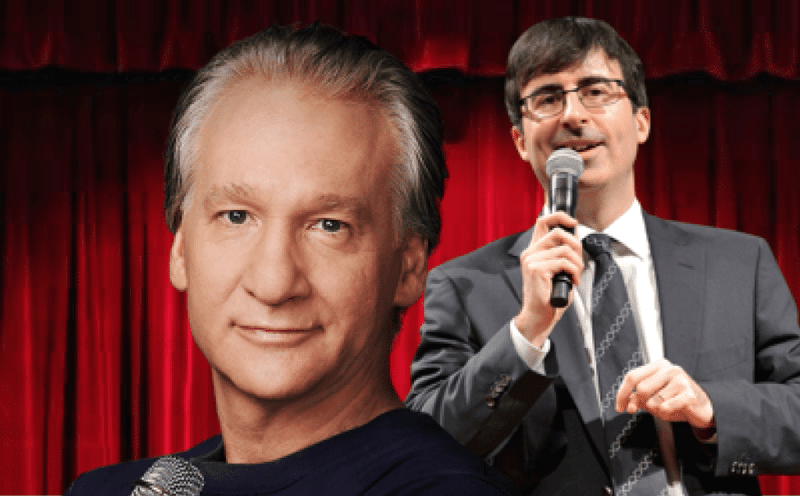
They surely have acquired such an audience — a liberal audience — in the Personality Insights™ sense, to degrees rather significantly exceeding the baseline.
But what of show number three? Is there a liberal agenda at play behind all the armor and swords and D&D soap opera?
Well, George R.R. Martin, the author the A Song of Ice and Fire series of fantasy novels which Thrones so vividly brings to life is an unabashed Democrat. He doesn’t blog and/or speak of politics often, but when he has he’s volunteered opinions such as Barack Obama is “the most intelligent president we’ve had since Jimmy Carter.” But is that personal feeling reflected in the work? Is Thrones a particularly liberal show?
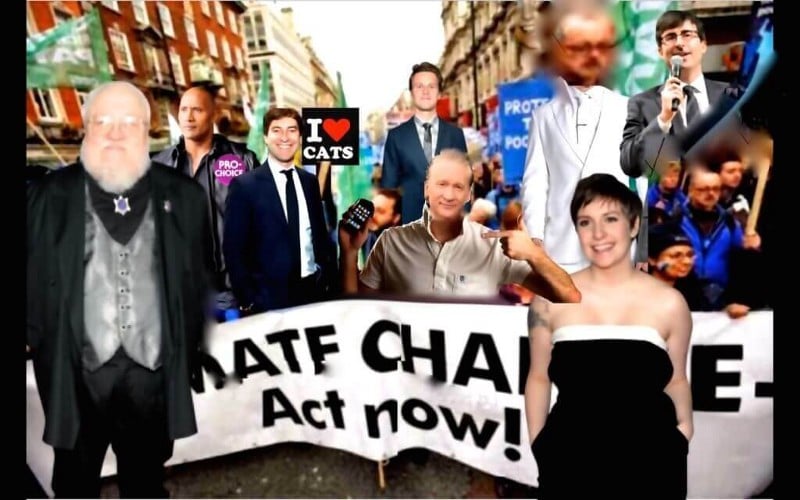
A purely hypothetical situation wherein HBO’s best and brightest gather to “make a difference.”
Martin is too good of a writer to allow his characters’ conflicts to be either so easily judged or resolved, and without turning this into a Thrones blog it could be said that his characters have at times exhibited heroism, or made choices clearly intended to be regarded as wise, that flouted political correctness and conventional liberal wisdom.
But they have always bucked authority. If the show has any central motifs, bucking authority is one of its strongest.
The program is nuanced, and its characters’ choices are not always obvious. This is why — while its audience is comfortably liberal — it still finds a not insignificant nearly 35% who do not identify as liberals among its fans.
It reminds one of the early-2000s HBO series, the widely hailed The Wire.While creator David Simon never made any bones about his liberalism, the program pulled in admirers from all corners.. So universal, finessed, and dead-on was the show’s critique of the bureaucracy and corruption consuming the average American city, and the show’s storytelling was so excellent, it found fans of all political and ideological stripes.
At a point it becomes not about left or right, and certainly not policy. It becomes about being human and asking yourself what would you do? When you can identify with a character, or can share in identifying an ill in society or in human nature, or share in an admiration of bravery and heroism, storytelling transcends mere politics. Liberalism in this sense is universally comprehensible.
Looking at the above chart two pieces of info which might seem missing.
“Was “liberalism” actually the top personality trait of the show in question?”
Then, “whatever its percent, if not the top Personality Insight™ of the show in question, what was?”
Interesting fact, one of the lowest ranked shows on this list found liberalism as its most defining personality trait. Whereas one of the top three, found liberalism a mere fourth on its personality list.
The characters on Girls more often speak of standing up to authority, or wishing they had the courage to do so, then actually doing so. Yet, their desire to make a mark in this world, to be iconoclastic, creative, and unique define them. It’s just that they’re less clear on how to go about accomplishing those things, and aren’t always motivated to do the work.
Looked at this way — and assuming such desires and apprehensions can be found among their core audience — their ranking makes perfect sense.
Here we’ve provided another colorful chart. It tells you which Personality Insight™ (usually imagination) the show’s audience most strongly identified with, and then shows where among their list of Personality Insights™ liberalism was ranked.
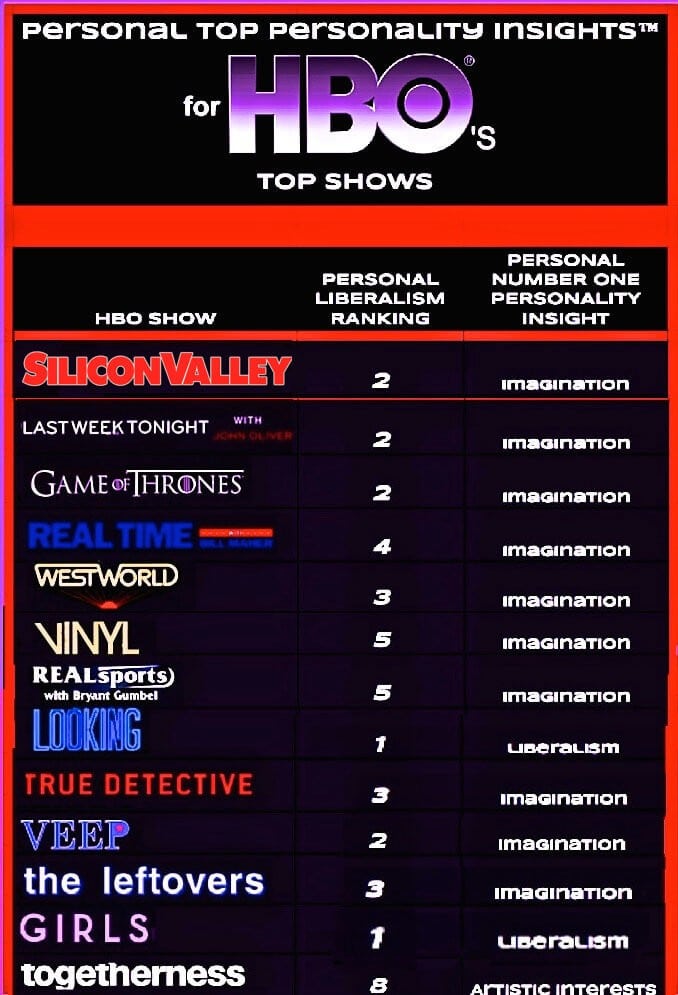
Yup, Girls’ strongest Personality Insight™ is liberalism, while still having one of the least liberal audiences by percentage. In addition to our above observations regarding ambition vs. reality, this type of statistic becomes much more easily achieved when a program’s social audience exceeds a million people, as does that of Girls.
And without belaboring the point it is precisely through THIS sort of insight that StatSocial gives marketers an edge. Girls’ top trait is liberalism. BUT, a vastly smaller portion of their audience fits this definition than most of the other shows. The added granularity and greater perspective change the story. If you use your imagination you could see how in some cases the added perspective of the bigger picture could change your plans quite a lot, and frankly you shouldn’t spend cent one without it.
The below chart might look okay, but it provides little in the way of surprising insight. Our having run it at all was cheeky and politically questionable. But it does demonstrate to you — the potential user of our magnificent StatSocial service — the granularity at your disposal when analyzing whatever audience it is that’s piquing your interest.
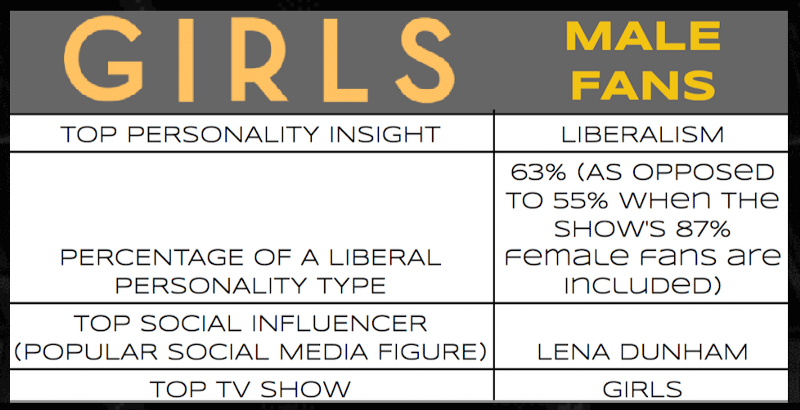
In this case we see if you were to eliminate the 87% of Girls’ audience that identifies as female, it would rank at around 6th place as opposed to 14th. We stopped making out chart after that as the male fans of Girls mirrored the female fans in nearly every relevant way. We had hoped for more in the way of revelation.
Anyway, we’ve gone on long enough. For goodness’ sake, 54% of the audience of BALLERS is identified as as having liberal personality type above all others. HBO, based on this criteria, and frankly more conventional criteria as well, is a liberal-leaning network.
HBO, we love you, and we really mean that. The writer of this blog entry remembers when you were on only on a few hours a day — in the late 70s — and anxiously waiting for you to start broadcasting.
I watched Young Frankenstein on you, with my father. The ‘Puttin’ on the Ritz” section made him laugh as hard as I’ve ever seen him laugh at anything, and that is an exceedingly fond memory. So you and me HBO, we’s cool.
But, love you or not, you’ve gotta admit, HBO? A little liberal. And according to Personality Insights™ definition, a lot.
To learn much more about StatSocial, the curious are encouraged to visit the StatSocial site itself, where you’ll find all sorts of stuff including sample reports.
— –
If you like what you’ve read, please take a few minutes to watch this overview of StatSocial’s data:
